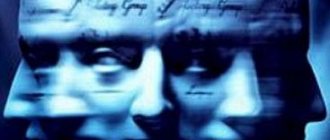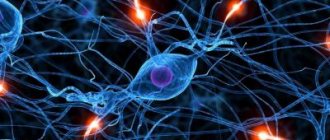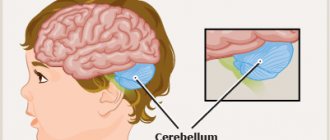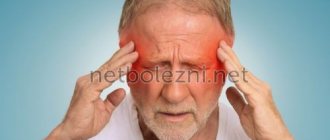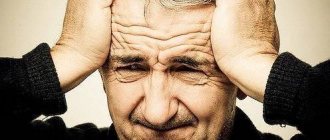What it is
What does a diagnosis of REP mean? The meaning of this abbreviation is residual encephalopathy. The disease is characterized by the death of neurons and impaired brain function. The word “residual” means “residual.”
This pathology is always secondary. It occurs as a residual phenomenon after suffering diseases of the central nervous system. This complication occurs when brain diseases are insufficiently or incorrectly treated.
Parents of children are often interested in what a diagnosis of REP in a child means. The decoding of this medical abbreviation is similar, it is residual encephalopathy. With adverse effects on the embryo or birth injuries, perinatal encephalopathy occurs. This disease is diagnosed in children in the first weeks and months of life. If the treatment of such a pathology was carried out poorly, then REP may develop in the future as a residual phenomenon. Often this complication does not appear immediately, but after several months or even years, and it can be difficult to diagnose.
Residual encephalopathy of perinatal origin
Residual encephalopathy of perinatal origin is a separate type of pathology that develops during gestation or during childbirth.
The diagnosis is made when the disease occurs from the 28th week of pregnancy until the end of the first week of life of the newborn child. The provoking factor is negative influences and brain damage.
The risk of developing residual encephalopathy of perinatal origin increases with the following factors:
- multiple pregnancy;
- premature or late birth;
- mother's age is over 40 or under 20 years;
- placental abruption during pregnancy;
- taking potent medications during pregnancy;
- other types of complications of a woman’s condition during pregnancy.
Causes
The diagnosis of REP is usually made to patients if they show signs of brain disorders after suffering pathologies of the central nervous system and other diseases that adversely affect the state of neurons. Residual encephalopathy most often occurs due to the following diseases and conditions:
- Severe head injuries accompanied by concussion or skull fractures.
- Congenital perinatal encephalopathy. This condition develops after birth injuries and a pathological course of pregnancy in the mother of the child.
- Inflammatory diseases of the brain.
- Excess urea in the body. This deviation is often observed in diseases of the liver and kidneys.
- Stroke and other cerebrovascular accidents. The cause of the pathology can also be vascular atherosclerosis.
- Diabetes mellitus. Endocrine disorders and excess glucose in the body adversely affect the condition of the nervous tissue.
- Toxin poisoning. Heavy metal compounds, certain medications, and alcohol have an adverse effect on the brain.
- Use of narcotic and psychotropic drugs. Even with timely detoxification, patients often retain signs of brain pathology.
Often the causes of this type of encephalopathy are several unfavorable factors. The physician must take a thorough history of the patient before diagnosing REP. This disease can develop after a fairly long period of time after suffering pathologies.
Classification of pathology
Residual encephalopathy can be congenital or acquired. In the first case, the pathology develops during the period of intrauterine formation of the fetus, in the second it arises due to certain negative factors affecting the child’s body after his birth.
Based on severity, residual encephalopathy is divided into three categories. At the initial stage of pathology development, brain tissue is affected. With moderate severity, clinical symptoms become more pronounced. The severe form is accompanied by persistent neurological disorders .
Congenital residual encephalopathy is divided into the following types:
Symptoms
Residual encephalopathy in an adult patient is accompanied by the following symptoms:
- Sudden memory loss. The patient becomes forgetful. He may have difficulty remembering even recent events.
- Decrease in intelligence. The patient's thinking process is disrupted due to the death of neurons and impaired cerebral circulation.
- Emotional lability. The patient's mood often changes, and there is increased irritability and tearfulness.
- Sleep disorders. Patients suffer from insomnia at night, and during the day they feel drowsiness and lethargy.
- Convulsive seizures. Seizures become more frequent as the disease progresses.
- Speech, vision and hearing disorders. The patient slurs his words. Vision and hearing deteriorate due to the death of nerve cells.
- Impaired coordination of movements. The patient's gait becomes unsteady, and he often loses his balance.
- Asthenia. The patient complains of constant fatigue and high fatigue.
- Headache. Migraine-like attacks occur. In this case, the pain syndrome is not relieved by analgesics.
These manifestations of pathology increase as the disease progresses. The more neurons die, the more severe the impairment of brain function.
What signs indicate a diagnosis of REP in a child? This disease can sometimes be difficult to identify in young children. After all, the baby cannot complain about feeling unwell. Parents should be alert to the following manifestations:
- tearfulness;
- increased reaction to external stimuli;
- frequent nausea and vomiting;
- weak sucking reflex;
- increased muscle tension;
- arrhythmia;
- exophthalmos (bulging eyes).
In older children, the disease is accompanied by the same symptoms as in adults. Residual encephalopathy has an extremely negative effect on the child’s intelligence. Children lag behind in mental and physical development, experience difficulties in assimilation and memorization of information, and it becomes difficult for them to study. Often, sick children experience sudden fainting.
Prognosis for cure
In order to cure such a serious illness as encephalopathy, it is necessary to pursue the main goal - to improve or at least normalize blood flow in the brain. For this purpose, special drugs are taken.
Non-steroidal and hormonal drugs have a good effect. A weakened body also needs a full complex of vitamins and minerals. Also, if indicated, anticonvulsants are prescribed.
In order to achieve the greatest result in the treatment of residual encephalopathy, especially in a child, the doctor may prescribe several methods:
- The first is a manual therapy session. It is a kind of massage that promotes blood flow to the brain, thereby increasing its functioning.
- Reflexology. This includes acupuncture and acupuncture. The purpose of this method is to influence the human body from the outside, using special points that can awaken its reflexes, which in turn will help the body “shake up” and turn on its protective functions.
- Special gymnastics and procedures can put a significant load on the entire body, which will bear fruit: a person’s muscle tone increases, blood circulation and blood flow to problem areas improve, provided that all the recommendations of a specialist doctor have been followed.
It should be noted that the treatment of residual encephalopathy in both children and adults is quite difficult and is accompanied by a large number of complications.
If residual encephalopathy was detected on time, and the doctor carried out the appropriate high-quality treatment, then all the symptoms will go away over time, and there is practically no reason for concern.
But if the disease begins to be treated at the last stage, then such treatment will not bring positive results, since the brain simply will not recover completely.
Several treatment methods are used in the treatment of residual encephalopathy. To normalize brain function, the child is prescribed special medications.
At the second stage of therapy, procedures are used that consolidate the results of medications (physiotherapy, physical therapy, therapeutic massage, etc.). If there are complications, a small patient may need surgery.
Treatment of residual encephalopathy uses the following drugs:
- vitamin complexes appropriate for the child’s age;
- anticonvulsants;
- medications to improve cerebral circulation;
- non-steroidal anti-inflammatory drugs;
- hormonal drugs;
- means to accelerate the regeneration of brain tissue.
Complications
How dangerous is a neurologist's diagnosis of REP? Without treatment, this type of encephalopathy can lead to the development of the following complications:
- severe dementia in adult patients;
- mental retardation in children;
- dropsy of the brain;
- neurocirculatory dystonia;
- paralysis;
- Parkinson's disease;
- epilepsy.
The likelihood of complications increases if the patient seeks help too late, when a significant number of nerve cells have died.
Pediatric neurologists often talk about minimal brain dysfunction when diagnosing REP. What does this mean? This complication is expressed in mental disorders in young patients. The child becomes restless, hyperactive, excitable, and often makes erratic movements. These manifestations intensify during puberty against the background of hormonal changes in the body.
Diagnostics
Before diagnosing REP, the doctor questions the patient and examines his medical record. It is necessary to identify all neurological pathologies that the patient suffered in the past. Additional research methods are also prescribed:
- electroencephalogram;
- MRI and CT of the brain;
- clinical and biochemical blood test;
- Dopplerography of cerebral vessels.
Brief biography 1.Klass
Artem Frank is a famous Russian rapper living in Germany, performing under the pseudonym 1.Kla$. I worked with difficult children and teenagers in an orphanage, but fell in love with rap music and met like-minded people. He began recording rap hits in German and Russian. He won battles, and his track “Like Hitler” simply blew up the Internet. Artem Frank's texts are aggressive and daring. They approved of drugs and an immoral lifestyle. It was as if he was declaring war on the usual foundations, challenging, and running into scandal. But part of the audience was delighted.
The artist disappeared from the sight of fans for several years, but then returned; his new hits also blew up the Internet.
Writes and performs songs in hip-hop and battle rap styles. Works with labels: RWRec, Optik Russia. Little is known about his personal life; he has a daughter.
Drug treatment
Treatment of this type of encephalopathy should be comprehensive. To restore normal brain function, patients are prescribed nootropic drugs:
- “Cinnarizine”;
- “Piracetam”;
- "Cavinton";
- “Noopept”;
- “Pantogam”
- "Phenibut";
- "Phenotropil".
These medications improve cerebral circulation and metabolism. It is useful to take them together with B vitamins. This will help restore normal functioning of the central nervous system.
For severe headaches, analgesics usually do not help. Therefore, patients are prescribed non-steroidal anti-inflammatory drugs:
For severe pain, treatment with corticosteroids: Prednisolone or Dexamethasone is recommended.
If the patient experiences frequent epileptic seizures, it is recommended to take anticonvulsants: Finlepsin or drugs based on valproic acid.
For increased irritability and mood swings, doctors prescribe mild sedatives: Afobazol, Glycine, Persen. These medications will help reduce emotional instability. In severe cases, antidepressants and tranquilizers are indicated.
Minimal Brain Dysfunction: Minimal Problems?
“Minimal brain dysfunction” - there is no such concept in world practice, this is an exclusively Russian universal formulation (more precisely, the CIS territories), a kind of “trash can” in which other, very real diagnoses can be placed (attention deficit hyperactivity disorder, anxiety disorders , depression, migraine, psycho-emotional disorder and even a regular tension headache).
That is, this is a kind of collective concept when the pathology is not clearly differentiated. If parents see such a conclusion about a child’s problem, this is a flag for them - they need to look further, or even go to the next doctor to clarify the diagnosis, since treating a non-specific concept means giving the child medicine almost “at random,” “maybe it will help.” This, of course, must be avoided. Since certain drug therapy can be prescribed only with a more precise diagnosis within the prescribed time frame.
On the other hand, “minimal brain dysfunction” is often pronounced in cases where there really are small deviations, but it will only be possible to understand whether they are a manifestation of an organic pathology or a peculiarity of the child over time. And, of course, this formulation should be followed by a clarifying diagnosis.
Parents can greatly facilitate the task of making an accurate diagnosis if they prepare for a trip to a specialist - before the consultation, they write down the main “problems” that, in their opinion, the child has. Abroad, psychiatrists and neurologists sometimes ask to make a short (5-15 minutes) video recording of “problematic” everyday moments: how a child communicates with peers, etc. Directly during the consultation, it is necessary to focus on complaints - restlessness, night terrors, thinking problems, poor attention when performing tasks, and so on.
The term mild brain dysfunction was coined by Czech pediatrician Zdenka Trzesoglava when she was trying to find some explanation for the fact that there are children in schools who have difficulty learning for various reasons. It may indicate immaturity of various brain structures, which may result in various cognitive disorders. In any case, it must be clarified using additional diagnostic techniques.
Other therapies
Drug treatment is supplemented with therapeutic massage sessions. This helps stimulate cerebral circulation. Therapeutic gymnastics is also useful. When performing exercises, you need to pay special attention to the collar area. Active neck movements help improve brain nutrition.
A child suffering from residual encephalopathy needs developmental activities. When correcting mental disorders, it is very important to train memory and attention. In cases of severe developmental delay, home schooling is indicated for school-age children.
Forecast
If the diagnosis of REP was made in a timely manner and the patient completed the full course of therapy, then the disease can be cured. Lost neurons can no longer be restored. But if the process of brain cell death has just begun, then therapy will help maintain the normal function of the central nervous system. Therefore, treatment is effective only at the initial stage of the pathology.
In advanced cases, it is no longer possible to restore lost brain functions. Even after treatment, the patient retains signs of memory impairment, thinking disorders and emotional lability. In children, this can lead to severe mental impairment.
Prevention
How to prevent the occurrence of residual encephalopathy? Prevention of this dangerous disease consists of observing the following measures:
- Injuries and pathologies of the central nervous system must be carefully treated.
- During pregnancy, women need to be under regular supervision by an obstetrician-gynecologist. It is also necessary to avoid any adverse effects on the embryo.
- We must try to prevent traumatic brain injuries in children.
- It is necessary to protect yourself from poisoning with toxic substances, and also stop drinking alcohol.
- Patients who have suffered pathologies of the central nervous system need to be regularly monitored by a neurologist and undergo all necessary examinations.
These recommendations will help avoid the occurrence of residual encephalopathy. It is important to remember that this disease is much easier to prevent than to cure.
. Is it possible to somehow separate neurology from psychiatry?
Help with advice. Sorry it’s long. No one among the doctors can explain anything intelligibly or wants to. We had an appointment with the district psychiatrist. There the nurse took one look at her son and immediately wrote him down as “our” patient. Somehow I immediately cut it with this phrase. The doctor sent us to 6, giving us to sign a paper that we agree to register the child with the PND, without this direction she will not give us. It turns out that we are already registered, with an unspecified diagnosis, without examination. And then you won’t jump off it even if in the 6th grade they won’t give you any kind of disability. Is it worth getting in there then? At the moment, 4.9 years old, ZPRR, no question, the rest is in question. We had a consultation at 18 neurological, with a psychiatrist - There is a serious delay in PRR, but you can’t scrape together the disability! The child does not communicate with children in the garden - does not play, does not talk, autistic traits are in question. Many doctors have already asked why you don’t register for a disability, but you don’t want to register and not get it at all.
. SO IS IT POSSIBLE TO SOMEHOW DISTINGUISH PSYCHIATRY FROM NEUROLOGY AND IF YOU HAVE A DISABILITY, YOU WILL NOT GET IT FROM A PSYCHIATRIST? With all our diagnoses, we are referred only to a psychiatrist. If your arms and legs move, then you don’t have neurology. Born at 34 weeks. And according to MRI and ultrasound, there are problems with Arnold-Chiari syndrome, delayed myelination of the occipital regions (at 1.10 years old there was a severe injury to the ice on the back of the head, untreated, concussion). The tonsils of the cerebellum have gone 8 mm into the posterior occipital foramen, blocking the normal outflow of liquor and blood flow. Hydrocephalus and increased pressure are created, sometimes the nose is blown with streaks of blood, the whites turn red. Frequent lethargy. He can’t say it, but by the movement of his eyes I can see that something is happening in his head. I myself have frequent dizziness, I also can’t focus my eyes, the roof is floating (there are also problems with blood vessels). Is this really not neurology with all the ensuing developmental delays, but only psychiatry. This is something that we ourselves were able to examine. They said that due to the threat of pinching the cerebellum and medulla oblongata (which could result in instant death), you should not tilt your head back, it is advisable to wear a Chance collar. Ultrasound shows cerebral ischemia, bradycardia and cardiac prolapse. So maybe he can get a non-psychiatric disability. It’s possible not to communicate with children not because of autism, but because of the inability to have the means to communicate and being afraid of what they don’t understand. With his sister, the same age, he only plays outdoor games, where he needs to communicate, she doesn’t play with him and he doesn’t interfere accordingly, because of his speech. He makes contact with pleasure if you invite him to play. He loves railways very much. He constantly builds tunnels and slides from cubes. He goes to normal kindergarten, without screaming or hysterics. But he doesn’t communicate there, he watches everyone, the children tried to contact him, but they couldn’t answer, and they didn’t bother him anymore either. Now he’s slowly saying something very clumsily, some of the most basic things. The speech therapist wrote alalia and sent me to the speech pathology center. My son is 4.9 years old.
Disability and F 70
A child with disability may be diagnosed with a disability. To do this, the child’s parents must be examined by a child psychiatrist. If, at the end of the consultation, the doctor decides that the child can be recognized as disabled, he will issue a referral to undergo a complex of medical and social expert commission.
After assessing the MSEC, the patient can be assigned one of three disability groups for the child. But not all children with such a diagnosis and not all medical institutions are given a disability. In some countries, people with this diagnosis are not assigned a disability at all. This right is given only to children and people with moderate, severe, and also advanced stages of the disease.
History of the image
Back in 1915, an American magazine published a satirical picture depicting two women at the same time. She became popular all over the world. For more than a hundred years, people simply looked at it and marveled at the skill of artist William Eli Hill.
This illustration went down in the history of famous optical illusions. It was reworked several times, creating many variations and similar images. But only a century later, scientists decided to study what people first see in a picture and how it depends on their age.
Weiss-Blau-Rot
The first album 1.Klass was released in 2004. It's called Weiss-Blau-Rot (which translates to "White-Blue-Red"). 1Kla$ and Czar recorded it together, the lyrics were in German. This album gained its fans, but it would be difficult to call it truly successful.
1.Kla$ began to perform in his native language, a year later the album “S***y Children” was released in Russian. Now it's solo. This album became more famous, fans began to appear in Russia, Germany and other countries. And the song “Like Hitler” spread across the Internet with lightning speed and made Artem famous among all rap fans. The public fell in love with him for his audacity, tough temperament, and simplicity of presentation.
In 2007, he released his second solo album: “Fuck in the mouth Styles”, and the album that the artist prepared again with rapper Czar, “Your Mother”. The texts were about sexual relations, non-traditional sexual orientation, offensive topics about women, addiction to alcohol and more.
The second of these collections was popular in Russian underground rap and could be seen on many sites offering rap music.
In 2008, the video 1.Klass - NRS (New Russian Standard) appeared. At the moment, this is the only clip in the creative biography of 1.Klass.
Perception Research
In the Australian city of Adelaide at Flinders University, scientists conducted an interesting experiment. They made a sample of 393 subjects aged from 18 to 68 years. The average age of the subjects was 32 years.
People were shown a picture for one second and asked to describe what they saw. This made it possible to assess the priority of perception of illusion.
According to the results of the study, scientists came to the conclusion: the younger the subject, the greater the likelihood that he will see a girl. Older subjects notice the old woman at first glance.
Assessing the approximate age of the woman they saw, people under forty gave her 20-25 years. Older people put the age of the person in the image at 50-80 years old.
They associate this effect with life experience and their own self-identification. The more a person has experienced in life or lived in years, the older the woman he saw.
Based on the results of the study, you can easily check yourself. You just need to take a quick look at the picture and give yourself an answer as to who is in the picture. If a girl, then the person is still young.
Materials used in the article:
https://conf.7ya.ru/popular/diagnoz-rjep-zrr-nevrologiya/
https://fb.ru/post/psychology/2018/10/20/31625
https://varicoz.net/vnus/
Post Views: 120
The beginning of the way
Friends and associates occupy an important place in the life and creative biography of 1.Klas.
At the university, Artem met and became friends with a Russian guy, Ivan Makhalov, who greatly influenced him. Ivan is also a rapper, performed under the pseudonym Czar (then his name was M. Makker). The guys formed the duo Divers, began to take their creativity more and more seriously, rehearsed a lot, and recorded songs in the studio.
In 2000, the duo took part in a rap battle in Bremen. The young performers won a landslide victory. This was a significant moment in the creative biography of 1.Klass.
Artem Frank gained fame and actively began to develop the Battle Rap style. No one could defeat him in battle. The rapper performed in various Russian clubs in Germany. And even the Russian accent did not prevent him from becoming successful in his field. He even had his own studio for recording music.

